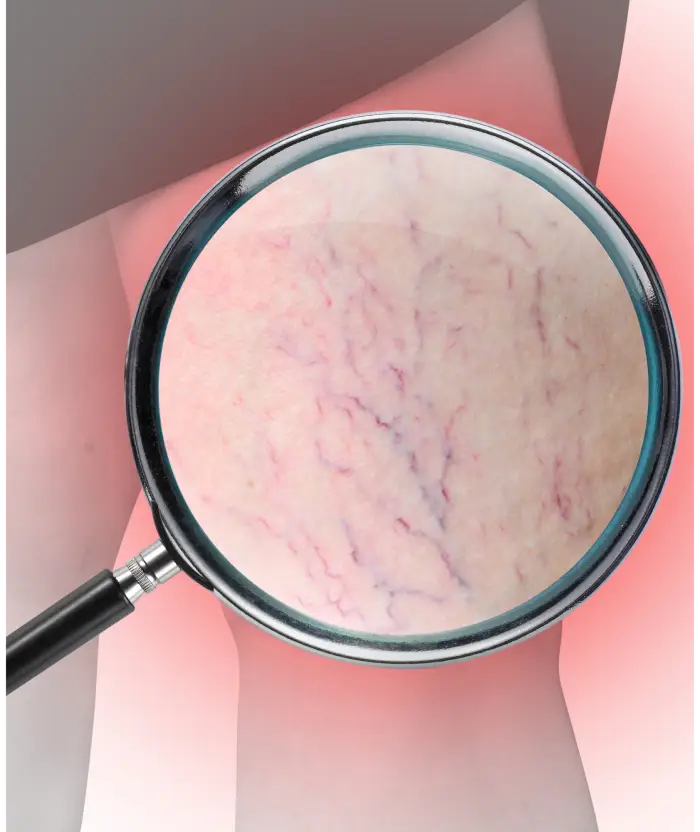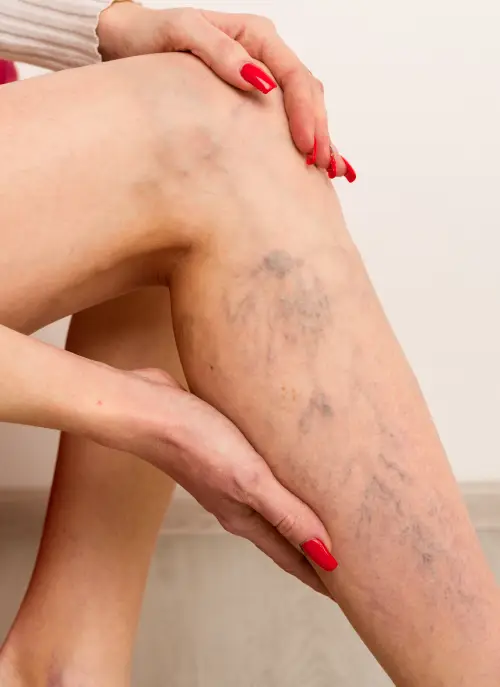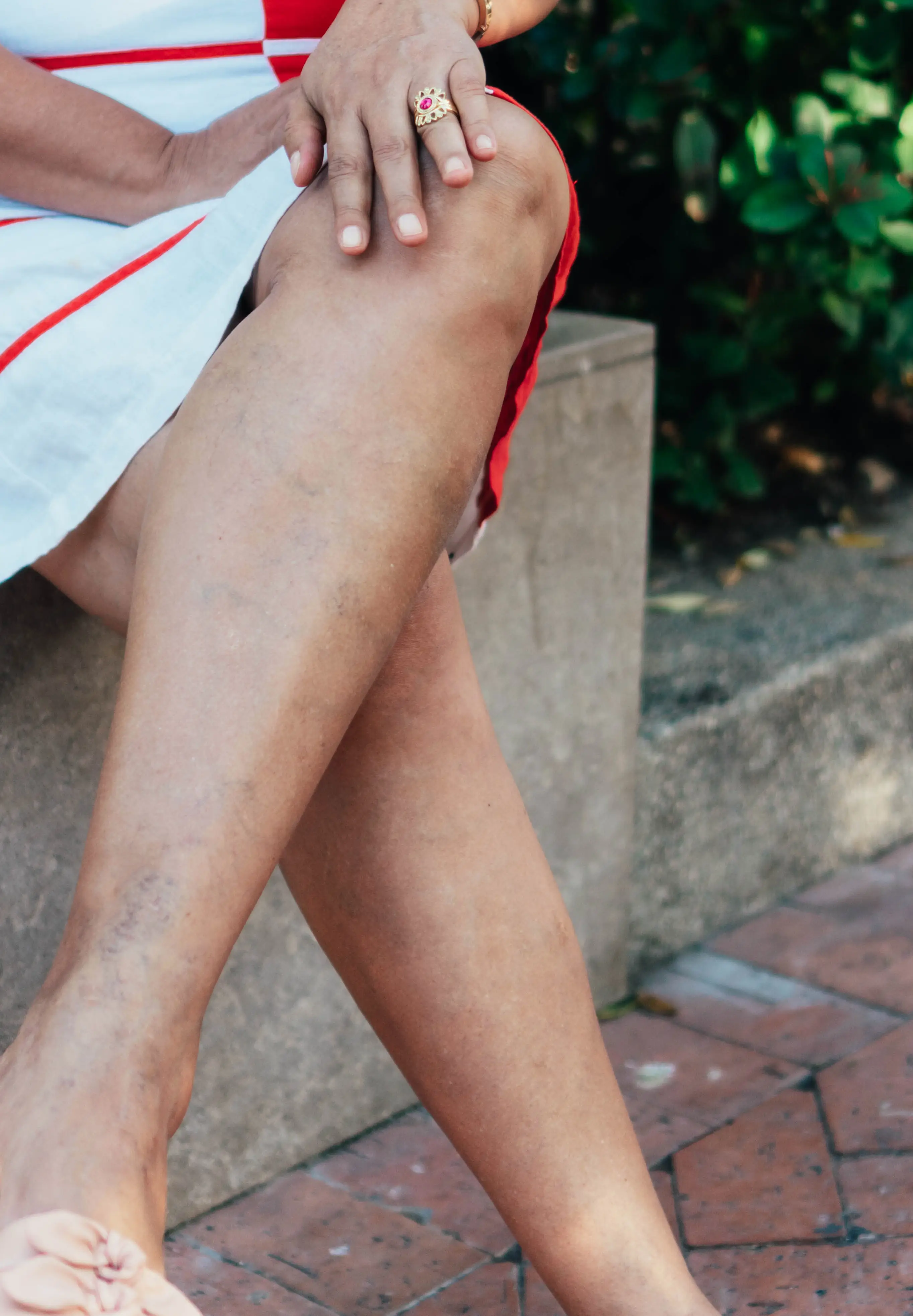Skin Health & Beauty Clinic. – Bournemouth
Leg Thread Veins Removal

What are Leg Thread Veins?
Leg thread veins, also known as spider veins or telangiectasia, are small, dilated blood vessels near the surface of the skin that appear as fine, red, or blue lines. They often have a web-like or tree branch pattern, resembling spider webs, hence the name “spider veins.” These veins are typically harmless and don’t cause symptoms like pain, but they can be a cosmetic concern for some individuals.
Benefits of
Leg Thread Veins
in Skin Health & Beauty in Bournemouth?
Leg thread veins, commonly referred to as spider veins or telangiectasia, are minute blood vessels situated close to the skin’s surface. They manifest as delicate lines in shades of red, blue, or purple on the legs, often forming intricate patterns reminiscent of spider webs. Although these veins typically do not cause discomfort or pain, their cosmetic impact may be a source of concern for some individuals.
Key features of leg thread veins include:
Visual Characteristics: Leg thread veins present as slender vessels with colours ranging from red and blue to purple, commonly appearing on the thighs, calves, and ankles.
Size and Texture: Differing from the more prominent nature of larger varicose veins, leg thread veins maintain a smaller profile, situated near the skin’s surface.
Pattern Formation: These veins tend to cluster, creating intricate patterns resembling spider webs or branching structures. Alternatively, they may exhibit subtler features resembling fine lines or miniature bursts akin to broken blood vessels.
Underlying Triggers: Leg thread veins can be influenced by various factors, including genetic predisposition, hormonal fluctuations, prolonged periods of sitting or standing, obesity, and exposure to sunlight. Certain medical conditions may also contribute to their development.


What treatment we use to remove leg thread veins?
FAQ
Frequently Asked
What causes spider veins on the face?
Leg thread veins, also known as spider veins or telangiectasia, can be caused by a variety of factors. While the precise cause may vary among individuals, common contributing factors include:
Genetics: A significant factor in the development of leg thread veins is a family history of this condition. If your parents or close relatives have experienced spider veins, you may be genetically predisposed to developing them.
Age: The likelihood of developing leg thread veins tends to increase with age. As the skin and blood vessels age, the veins may weaken, leading to the development of visible thread veins.
Gender: Women are more prone to leg thread veins than men. Hormonal changes, particularly during pregnancy, childbirth, and menopause, can contribute to the development of spider veins.
Hormonal Changes: Fluctuations in hormones, such as those occurring during puberty, pregnancy, and menopause, can play a role in the development of leg thread veins. Birth control pills and hormone replacement therapy may also influence their appearance.
Prolonged Standing or Sitting: Jobs or lifestyles that involve extended periods of standing or sitting may contribute to the development of leg thread veins. This can be due to increased pressure on the blood vessels.
Obesity: Excess body weight puts additional pressure on the veins, especially in the lower body. This increased pressure can contribute to the development of spider veins.
Sun Exposure: Exposure to ultraviolet (UV) radiation from the sun can damage the skin and blood vessels, potentially leading to the appearance of leg thread veins. Sun damage weakens the skin and may affect the integrity of blood vessels.
Injury or Trauma: Injuries to the skin or underlying blood vessels can contribute to the development of thread veins. Trauma may weaken the vessel walls, making them more susceptible to dilation and visibility.
Medical Conditions: Certain medical conditions, such as venous insufficiency or circulatory disorders, may contribute to the development of leg thread veins. Chronic conditions that affect blood flow can increase the risk.
Hormone Therapy: Some hormonal treatments, including estrogen-based medications, can influence blood vessel dilation and contribute to the appearance of spider veins.
How can I get rid of facial spider veins?
Sclerotherapy is a common and effective procedure for treating leg thread veins, also known as spider veins. Here’s an overview of how sclerotherapy works and the steps involved in the process:
1. Consultation:
Before undergoing sclerotherapy, you will have a consultation with a healthcare professional, typically a dermatologist or vascular specialist. During this consultation, your medical history will be reviewed, and the extent of the leg thread veins will be assessed.
2. Preparation:
On the day of the procedure, you may be asked to wear loose and comfortable clothing. The area to be treated will be cleaned, and you may be asked to avoid applying lotions or creams to the skin.
3. Injection of Sclerosing Solution:
A fine needle is used to inject a sclerosing solution directly into the targeted leg thread veins. This solution irritates the lining of the veins, causing them to collapse and stick together.
4. Compression:
After the injection, compression may be applied to the treated area. Compression stockings or bandages help to compress the treated veins, preventing blood from re-entering and promoting the closure of the vessels.
5. Monitoring:
The healthcare professional will monitor the treated area to ensure there are no adverse reactions. You may be asked to remain in the clinic for a short period for observation.
6. Post-Treatment Care:
Following sclerotherapy, it’s essential to follow post-treatment care instructions provided by your healthcare professional. This may include wearing compression stockings for a specified period, avoiding strenuous activities, and refraining from sun exposure on the treated area.
7. Results and Follow-Up:
Improvement in the appearance of leg thread veins is typically seen over several weeks as the treated veins gradually fade. Multiple sessions may be required for optimal results, depending on the extent and severity of the veins.
How do I prevent leg thread veins?
While it may not be possible to prevent leg thread veins entirely, certain lifestyle changes and practices can help reduce the risk of their development and minimise their appearance. Here are some preventive measures:
Regular Exercise:
Engage in regular physical activity to improve overall circulation and strengthen leg muscles. Activities such as walking, swimming, and cycling can be beneficial.
Maintain a Healthy Weight:
Maintain a healthy weight to reduce pressure on the veins. Excess body weight can contribute to the development of leg thread veins.
Avoid Prolonged Sitting or Standing:
Take breaks and change positions regularly if your job involves prolonged sitting or standing. This helps prevent blood from pooling in the legs.
Elevate Your Legs:
Elevate your legs when resting or sleeping to encourage blood flow back to the heart. This can help reduce the risk of blood pooling in the lower extremities.
Compression Stockings:
Consider wearing compression stockings, especially if you have a family history of leg thread veins or if you’re at an increased risk. These stockings apply gentle pressure to the legs, promoting better circulation.
Healthy Diet:
Consume a diet rich in fruits, vegetables, and high-fiber foods. A diet that supports overall cardiovascular health can contribute to optimal blood flow.
Stay Hydrated:
Drink an adequate amount of water to maintain hydration levels. Proper hydration supports blood circulation.
Sun Protection:
Protect your skin from excessive sun exposure by using sunscreen. Sun damage can weaken the skin and contribute to the development of leg thread veins.
Avoid Tight Clothing:
Avoid wearing tight clothing, particularly around the waist and thighs, as it can impede blood circulation.
Regular Movement:
Incorporate regular leg movements, such as ankle circles and toe stretches, especially during long periods of sitting.
Hormonal Management:
If you are on hormonal therapy, such as birth control pills or hormone replacement therapy, discuss the potential impact on vein health with your healthcare provider.
Genetic Counseling:
If you have a family history of leg thread veins, consider discussing your risk with a healthcare professional and exploring preventive measures.
Regular Check-ups:
If you notice the development of leg thread veins or have concerns about your vascular health, consult with a healthcare professional for guidance and appropriate intervention
Where can leg thread veins removal treatment near me?
At Skin Health & Beauty Clinic in Bournemouth, located in Pokesdown, near Christchurch and Southbourne in Dorset. Our address is 878, Christchurch road, Bournemouth BH76DJ
Are Leg thread veins dangerous?
Does Leg thread veins hurt?
Leg thread veins, commonly known as spider veins or telangiectasia, are generally considered a cosmetic concern rather than a health risk. They typically do not cause physical symptoms, although some individuals may experience mild sensations like itching or burning. While leg thread veins themselves are not dangerous, they may be associated with underlying venous conditions, such as varicose veins, which can have more significant implications. Treatment options, such as sclerotherapy or laser therapy, are often pursued for cosmetic reasons to reduce the visibility of these veins. If individuals notice sudden changes, discomfort, or other concerning symptoms, seeking medical advice is advisable to rule out more serious vascular conditions and determine the most appropriate course of action.
How many Leg thread veins will I need?
What aftercare is required after Leg thread veins removal treatment?
After undergoing leg thread veins removal treatment, whether through sclerotherapy, laser therapy, or another method, it’s essential to follow specific aftercare instructions provided by your healthcare professional. While these recommendations may vary based on the type of treatment, here are some common aftercare practices:
Compression:
If you underwent sclerotherapy or another treatment that involved injecting a solution into the veins, your healthcare provider may recommend wearing compression stockings. Compression helps improve blood flow, reduces swelling, and supports the healing process.
Avoid Sun Exposure:
Protect the treated areas from direct sunlight for a specified period. Sun exposure can potentially cause pigmentation changes and affect the healing process. If exposure is unavoidable, use sunscreen with a high SPF.
Physical Activity:
Engage in light activities such as walking, but avoid strenuous exercise or activities that may strain the treated area. Your healthcare provider will provide guidance on when it is safe to resume more intense physical activity.
Avoid Hot Baths or Saunas:
Stay away from hot baths, saunas, or hot tubs for a specified period after treatment. Elevated temperatures can dilate blood vessels and may interfere with the healing process.
Avoid Certain Medications:
Your healthcare provider may recommend avoiding certain medications, such as nonsteroidal anti-inflammatory drugs (NSAIDs) or blood-thinning medications, for a specific time following treatment. Always follow your provider’s advice regarding medications.
Monitor for Side Effects:
Keep an eye on the treated areas for any unusual reactions. While some redness, swelling, or bruising may be expected, notify your healthcare provider if you experience severe pain, infection, or other concerning symptoms.
Follow-up Appointments:
Attend any scheduled follow-up appointments as advised by your healthcare provider. This allows them to assess your progress, make any necessary adjustments, and ensure that the treatment is achieving the desired results.
Hydration and Healthy Diet:
Stay well-hydrated and maintain a healthy diet rich in nutrients. Proper hydration and nutrition support overall healing and skin health.
Patience and Compliance:
Understand that the full results of the treatment may take time to manifest. Follow all aftercare instructions diligently and be patient during the healing process.
Consultation for Concerns:
If you have any concerns or experience unexpected side effects, promptly contact your healthcare provider for guidance. They can address your questions and provide assistance as needed.
sKIN HEALTH & BEAUTY CLINIC & ACADEMY ADDRESS
Find our Clinic
Opening Times
| Day | Hours |
|---|---|
| Monday | 10:00 - 14:00 16:00 - 20:00 |
| Tuesday | 10:00 - 16:00 |
| Wednesday | 10:00 - 14:00 16:00 - 20:00 |
| Thursday | 10:00 - 14:00 16:00 - 20:00 |
| Friday | 9:30 - 14:00 16:00 - 20:00 |
| Saturday | 10:00 - 17:00 |
| Sunday | 10:00 - 12:00 |
Clinic Address
878, Christchurch road, Bournemouth BH76DJ
Telephone
07393 770773
Finding us
Our clinic is located on the left hand side of Christchurch Road a few meters away from Kwik Fit towards Iford roundabout, just at the Hannington Road Bus Stop. There is plenty of transport link to Bournemouth, Poole and Chirstchurch all day and free parking outside the clinic for an hour and in the side roads unlimited.
